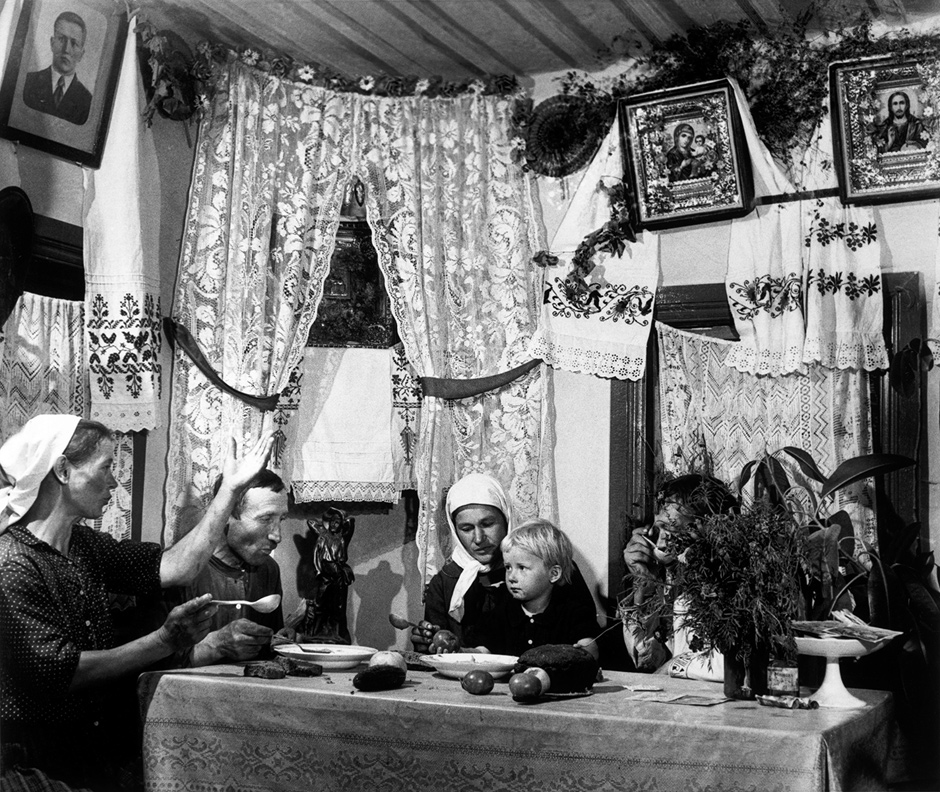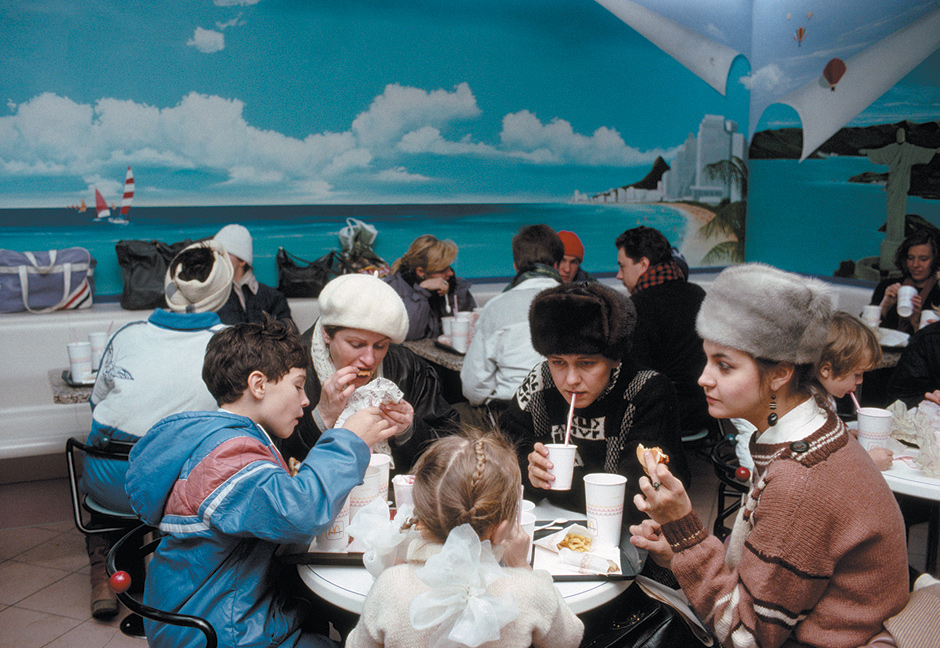Russians have told so many lies about themselves they hardly know who they are anymore. In the 1990s, President Boris Yeltsin created a federal commission to draft a text describing the “national idea.” These days, President Vladimir Putin talks gibberish about Russia having a “cultural code,” which he seems to imagine is some sort of a spy code for the spirit. They should have started with food. There is no common Russian equivalent for the saying “you are what you eat,” but it is no accident that Russians have hardly any idea of distinctively Russian food—except perhaps bad sushi, which is served in Moscow restaurants that claim to be Japanese as well as in those labeled as Italian, Georgian, French, Russian, or any number of other national cuisines. Then there is mayonnaise, which saturates all traditional holiday dishes. And, most recently, sushi made with mayonnaise.
On an August day in the early 1970s, little Anya von Bremzen, visiting Odessa from Moscow, was instructed by her relatives to watch “true Jewish food” being prepared. The process was interminable, the heat was intolerable, the whole place smelled of fish, and Anya ran away. “I suppose you can’t blame a late-Soviet big-city kid for fleeing the primal shock of gefilte fish,” she writes. Except for a notation in her mother’s passport, and the passport of every relative on her mother’s side of the family, there was nothing Jewish about Anya: she was a Soviet child, which meant she ate pork fat (“Of course we ate pork fat. We loved it.”) and was profoundly cynical. Her new book traces how she, and Soviet culture, got to be that way. Mastering the Art of Soviet Cooking is an unfortunate title, for it makes the work sound like a cookbook—von Bremzen has written several excellent ones in the past—but this is something else entirely.
Nor is it, as the subtitle indicates, solely “A Memoir of Food and Longing.” It is a painstakingly researched and beautifully written cultural history but also the best kind of memoir: one with a self-aware narrator who has mastered the art of not taking herself entirely seriously. It is also a breathtaking balancing act inasmuch as it tells the story of von Bremzen’s relationship with her mother, Larisa, a love story told with enough candor to trouble the reader—but not Larisa herself, who emerges as both a character and a collaborator in the book.
The story of Soviet cooking begins with the devastation of the Russian economy during World War I, causing bread shortages and a series of upheavals that culminated with the Bolsheviks in power. Over the first two decades of their rule, the Soviets annihilated not only much of the peasantry that produced Russia’s food but also the bourgeoisie that cooked and consumed it. In the lifetime of the first Soviet generation, the memory of tsarist cuisine, its recipes and its tastes, was lost. Anya and Larisa, however, emigrated to the West just early enough—in 1974—to dine at the tables of the last of the White émigrés. “Suckling pig stuffed with kasha, wickedly rich Easter molds redolent of vanilla, the Chekhovian blini plumper than ‘a shoulder of a merchant’s daughter’—we tasted it all.”
The Soviet Union, meanwhile, was running out of food: the empty store shelves of the late 1980s made the empty store shelves of the late 1970s seem plentiful in comparative memory—some days, it had been possible to buy a chicken, or even a stick of sausage. By 1991, everything, including vodka and cigarettes, was rationed, and the Kremlin was cooking up desperate schemes for trading reserves of precious metals and natural resources for food—any food from anywhere.
Most of the White émigrés died off, the Soviet Union collapsed, and an emergent class of the new Russian rich gorged on pizza, hamburgers, and something they called sushi for the better part of a decade before trying to recreate food they remembered from their childhoods or from literature. On a sweltering evening in the 2010s, at the start of writing this book, Anya and Larisa served a tsarist meal to a small, select group of Russian-American and just-American culturati at Larisa’s apartment in Queens.
Despite the local shortage of burbot liver and viziga (“the desiccated dorsal cord of a sturgeon,” von Bremzen explains, as though this clarified anything), they appear to have succeeded in preparing the most old-fashioned, time-consuming, and fat-saturated meal ever served in the New World. Assorted appetizers; vodka steeped on horseradish; homemade kvass, a low-alcohol brewed drink made with rye bread; botvinya, a disembodied word from Russian literature that turns out to have stood for a chilled fish-and-greens soup; Guriev kasha, a dessert composed of grain and candied nuts, the making of which involves skimming the skins off at least fifteen separate portions of baking cream. Most treasured of all, the kulebiaka, a multitiered tower of a pie that houses, within its yeast dough casing, dilled rice, fish, wild mushrooms, and—shockingly—blini as the butter-soaking separators of the layers.
Advertisement
Von Bremzen includes one recipe for every meal described in her book—and there is a meal for every decade of the Soviet century. Recipes range from the dreaded gefilte fish to a particularly fanciful borscht—dishes that coexist only in this book and, so far as I know, at Veselka Cafe in the East Village, for only in these places can a quintessentially Ashkenazi Jewish dish and a quintessentially Ukrainian one be united by their geographic origin rather than forced apart by their ethnic ones. The recipe for kulebiaka, however, is much simplified compared to the edifice Larisa is described constructing in her Queens kitchen—and still it looks too daunting for most cooks to undertake at home.
Von Bremzen is as much a virtuoso in her writing as her mother is in her cooking. In lucid prose she builds a scene until she can get away with feeding the reader this: “And so it was that about once a week we got to eat shit destined for the economic criminal’s garbage. To us, it tasted pretty ambrosial.” This is the story of their neighbor in a communal apartment, a corrupt food store manager who cannot stomach all that he manages to pilfer from the people’s food supply—so Larisa and Anya are allowed to pick up his family’s surplus luxury droppings, such as pieces of batter-fried chicken. Von Bremzen thus gives some plausibility to the act of coveting one’s neighbor’s food as well as to the word “ambrosial,” which shows up in the book several more times. Every time it appears, the reader flashes back to the flat shared with the pilferous manager.
Food in Russia served as an instrument of control and an unparalleled mark of privilege. The more barren the shelves of ordinary stores became, the more minutely identified the levels of nomenklatura privilege were: those on the lower rungs could receive special monthly packages containing bologna, smoked salmon, and salmon roe caviar. Climbing up the Party ladder, one could have Servelat, smoked sturgeon, and sevruga caviar. Closer to the top, the goods stopped being apportioned and flowed freely, via closed-access stores and food distribution centers.
Von Bremzen draws an unusually nuanced picture of Soviet privilege because, like many children of the quasi-dissident intelligentsia, she lived on its margins. Von Bremzen’s grandfather was a Soviet intelligence officer. Larisa rejected his privileges and his politics—until she was forced to subject her five-year-old daughter to the hell of a Soviet preschool, with sadistic teachers and food that was literally rotten. Granddad the Spy arranged to have little Anya enrolled in a preschool for children of members of the Central Committee.
The preschool sat in a lot shaded by tall pine trees planted in 1933 on orders of Joseph Stalin, whose boarded-up dacha stood just a couple of hundred yards away. When ordinary children in ordinary preschools were fed sour shchi, a cabbage soup, that reeked of rotten vegetables, and moderately privileged children received fish oil supplements, the offspring of the Central Committee were fed sevruga caviar by the spoonful. Anya gagged on it. Stuck between, on the one hand, the preschool’s riches and unremitting Party rhetoric and, on the other, her mother’s disdain for both, the five-year-old developed what can only be described as an eating disorder.
A mere fifteen years before Anya von Bremzen started dumping her nomenklatura food behind the radiator at her preschool, Stalin had stopped gorging himself during midnight meals at his dacha next door. He called his favorite dish Aragvi, after a Georgian river, but on the basis of her archival research von Bremzen exposes it as chanakhi, a basic Georgian stew made with lamb chops, baby eggplants, tomatoes, onions, and herbs. Recreating the dictator’s favorite dish for her chapter on the 1950s causes the author and her mother some consternation.
Following the death of the tyrant, the Soviet dictatorship softened, matured, regrouped, and mutated. Ideology gradually fell away and shriveled, exposing a society with a rigid class structure and a terminally stagnant economy. During what Russians often refer to as the “vegetarian” decade of the 1970s, the state turned a blind eye to many violations of its economic laws, allowing some heretofore banned exchanges of goods and services to occur and a Soviet brand of consumerism to flourish.
The non-nomenklatura class, which had been living at a uniformly low level of subsistence, developed uniform ambitions: a three-room apartment, a boxy Zhiguli car, and a plywood summerhouse on a plot of exactly six hundred square meters (roughly 6,500 square feet). Plus exactly one pair of Levi’s and one sheepskin jacket for each adult member of the family. With the exception of the jeans and jackets, these signs of moderate wealth carried absurdly low price tags in rubles but required large investments of social capital, also known as blat, a word that rolls social connections and corruption into one. Blat was the ultimate currency of what the regime itself described as Mature Socialism.
Advertisement
A true child of her age, schoolgirl Anya set about accumulating social connections. She used the lucky location of the family’s apartment—something like Moscow’s Embassy Row—to make friends with the children of emissaries of Ghana and Sierra Leone. From these friendships she could extract
prestigious imported goods. Ballpoint pens, Donald Duck stickers, Smarties, Wrigley’s Juicy Fruit, and Turkish Mabel gum with a picture of a be-turbaned belle on a shimmery wrapper.
These she used in turn to procure favors and, of course, meals—at the Academy of Sciences clubhouse, a turn-of-the century mansion replete with chandeliers and gold leaf. Anya was meant to be studying dance there:
Once Mom came to pick me up early and the dance teacher reproachfully motioned her toward the restaurant. There I was, a proper black marketeer, at my regular corner table under a gilded mirror, enjoying a personal cocotte pan of wild mushroom julienne.
It was this splendor and this sense of self-sufficient superiority that Larisa proposed Anya give up in order to emigrate when the option first presented itself, tentatively, to Soviet Jews in the early 1970s. Larisa had hated her country as long as she could remember; Anya loved her life. But she also loved her mother. “And so for her sake I said an insincere Brezhnevian ‘yes’ to her emigration plans.”
Landing in northeast Philadelphia and working as a cleaning woman, Larisa embraced America with all the enthusiasm of a 1930s Young Pioneer. Her daughter suffered the unique pain and confusion of an émigré child: she was eleven, and zagranitsa, “the other side of the border,” was nowhere as glossy and tasty as she and most of her former compatriots had imagined:
I hated the Pathmark of Northeast Philadelphia. It was the graveyard of my own zagranitsa dream, possessed of a fittingly funerary chill and an otherworldly fluorescence. Shuffling the aisles, I felt entombed in the abundance of food, now drained of its social power and magic. Who really wanted the eleven-cent bag of bananas if you couldn’t parade it down Kalinin Prospect inside your transparent avoska after standing in a four-hour line, basking in envious stares? What happened when you replaced the heroic Soviet verb dostat’ (to obtain with difficulty) with the banal kupit’ (to buy), a term barely used back in the USSR? Shopping at Pathmark was acquisitioning robbed of thrills, drama, ritual. Where did blat come into play, with its savvy maneuvering of social ties, its camaraderie? Where was envy and social prestige? The reassuring communal ochered’ [queue] smell of hangovers and armpits? Nobody and nothing smelled inside the Pathmark.
Sixteen years later, as the Soviet Union was breaking apart, Anya von Bremzen, a young American under contract to write a cookbook, returned on a culinary tour of the imploding empire. For seven decades Soviet propaganda had celebrated the “friendship of the peoples” by representing a little bit of each Soviet ethnic cuisine in the capital. Moscow had a Georgian restaurant and an Uzbek one as well as an Armenian food store in the very center of the city. Now food was reclaiming its rightful place as a marker of difference. In Uzbekistan, Uzbeks and Tajiks derided each other’s version of palov (meat pilaf); von Bremzen concluded they were identical. She includes a recipe for either or both.
Having watched war break out at the seams of the empire, or perhaps having simply traveled in and out of what used to be her homeland on her own terms, von Bremzen made peace with being an American. She became one of the most celebrated food writers in the US, and did not visit Russia again for ten years. While she was gone, Russia lived through one of the most traumatic decades in its tragic history. For most of the country, the experience was like waking up one morning inside the Pathmark of northeast Philadelphia but lacking even the eleven cents for a bunch of bananas. By the end of the 1990s, Russians had elected a former KGB officer as president and he had set about restoring the country to an imaginary Russo-Soviet state.
Eateries specializing in Soviet nostalgia had started popping up in the late 1990s. In the 2000s they stopped being novelties and became part of everyday life. Muscovites paid good money to eat at a place called Stolovaya (“eatery”), as every fast-food establishment had once been called, or drink at a place called GlavPivBar (“Main Beer Sales”), a salute to Soviet acronyms. Soviet-nostalgia cuisine became mixed with Imperial-Russia-nostalgia cuisine, of which neither today’s Russians nor their parents or grandparents had any living memory.
Twenty years after writing her Soviet cookbook, von Bremzen was invited to film a television show on Soviet culinary history. “But isn’t Moscow full of people who remember the USSR a lot better than I do?” she asked the producer. “I mean, I’m from New York!”
“Here we have mishmash for our memory,” the producer responded. “But an émigré like you—you remember things clearly!” The producer was a cultural anthropologist who had written about the 1932–1933 Ukrainian famine, the single most terrifying example of the Soviets’ use of food supplies to control the population; the death toll has been variously estimated between 1.8 and 7.5 million. She was now running a state-owned twenty-four-hour television food channel.
Anya and Larisa filmed their show with a former Kremlin chef. The crew couldn’t get enough of their stories, and they couldn’t get enough of one another. This was the definition of a triumphant return: they were on national television, speaking as the quintessential Russians.
But as anyone who has traveled knows, we are not just our food: we are also our footwear. It is what one puts on one’s feet that gets one noticed and brings privilege or punishment in a strange land. In 2011 in Moscow, one of the world’s most expensive and most primitively fashion-conscious megapolises, Anya von Bremzen stepped out in flip-flops. She was stared down, reprimanded, reprimanded again, and exposed to one of Moscow’s most pertinent characteristics: it is a city that loathes differences. The only people who didn’t berate von Bremzen for her footwear were migrant workers from Central Asia—a very large (estimates are in the millions) and very maligned population that does much of the work of the city. One, a street cleaner, confided that Moscow is a “mean city.” Another, a sales clerk at an absurdly overpriced faux farmer’s market in the center, said that Moscow is a “mean city.” When von Bremzen got home to her short-term rental apartment, Larisa said the same thing.
Nostalgia dishes, no matter how many are eaten, will not tell Russians who they are. Vladimir Putin’s “cultural code” is easily broken. It stands for rabid xenophobia, expressed in laws against “foreign agents” and “homosexual propaganda” and in hate violence against assorted enemies that has become epidemic. For their final recipe of the book, the one that represents the twenty-first century, Anya and Larisa chose blini, a food traditionally consumed at wakes.





